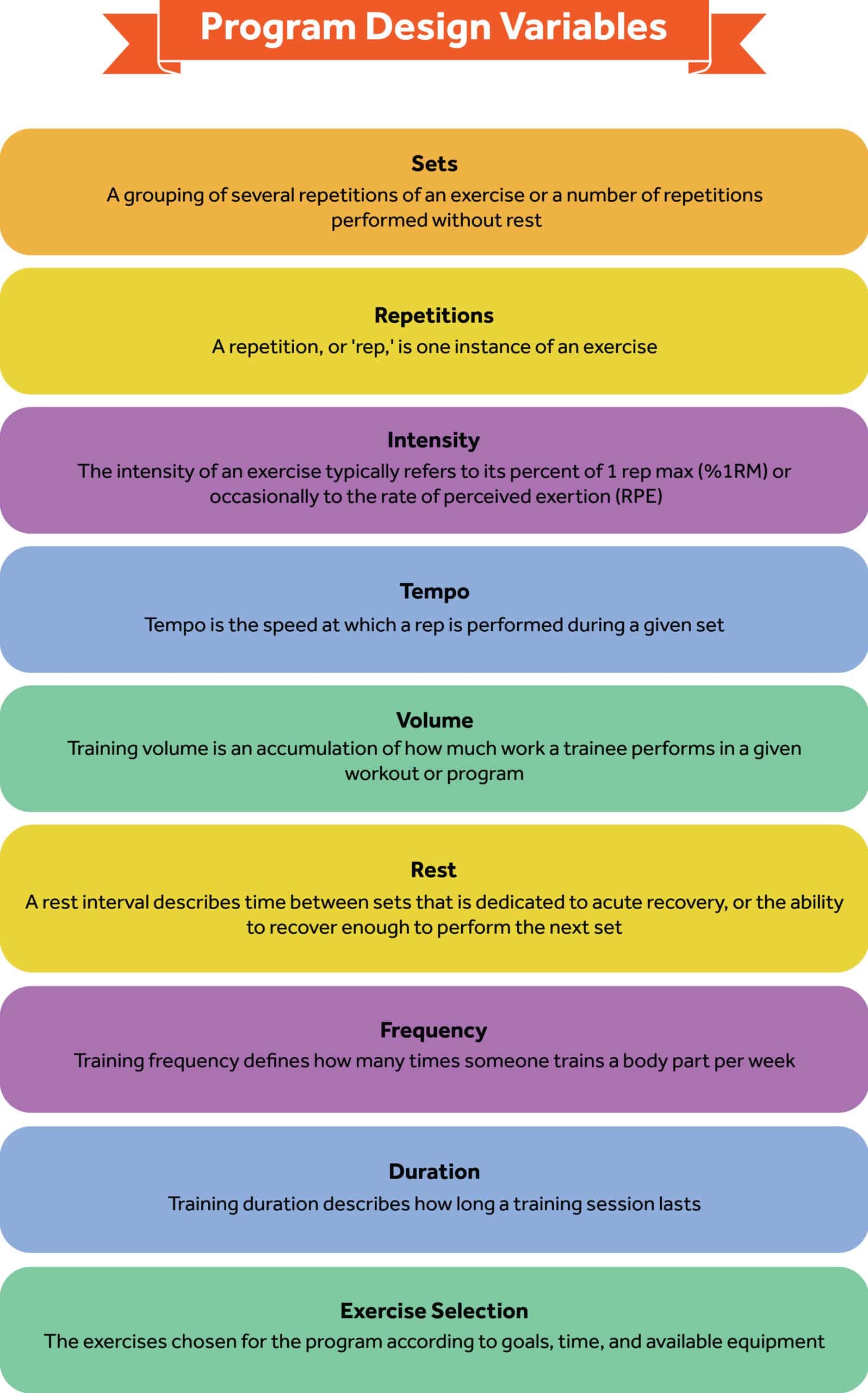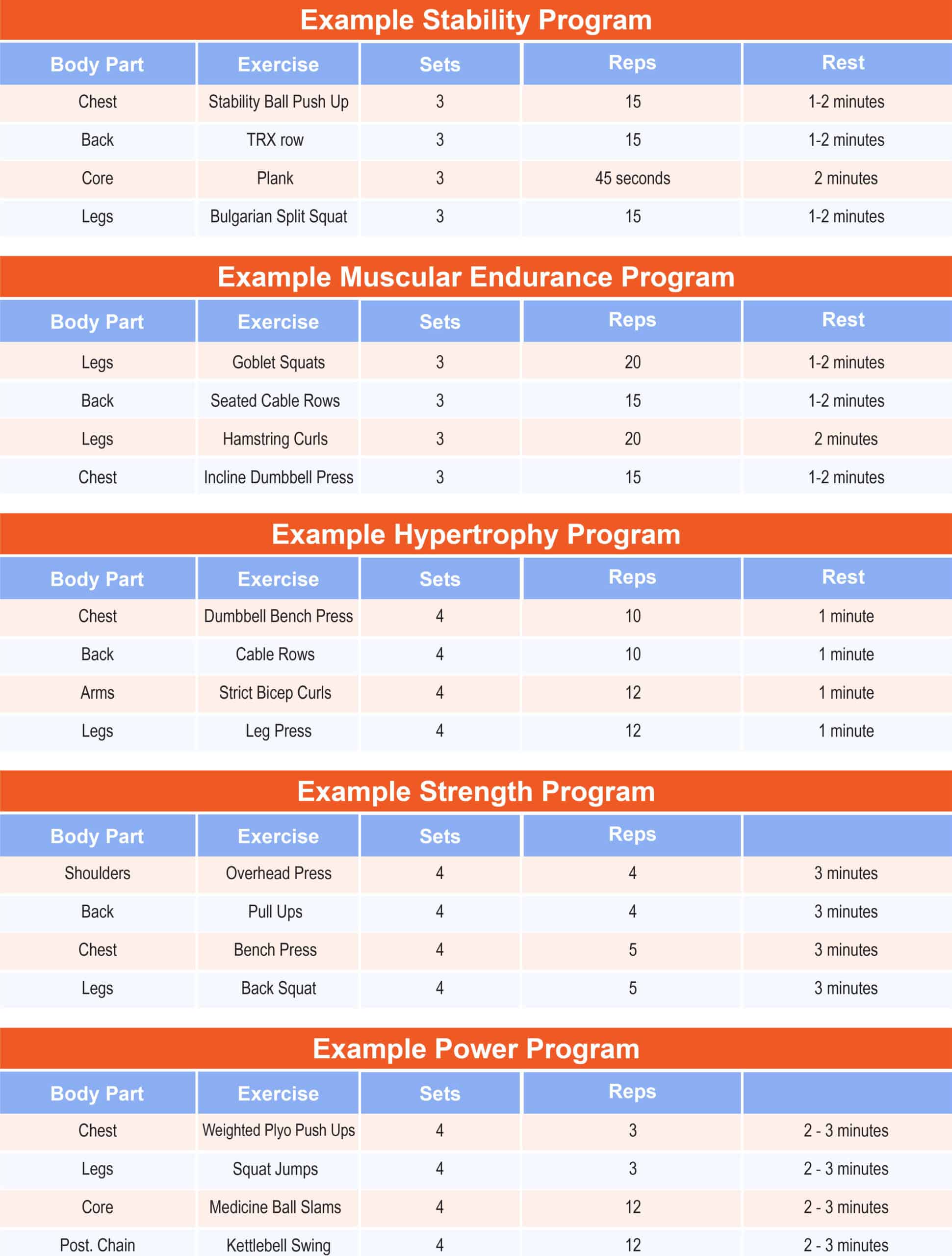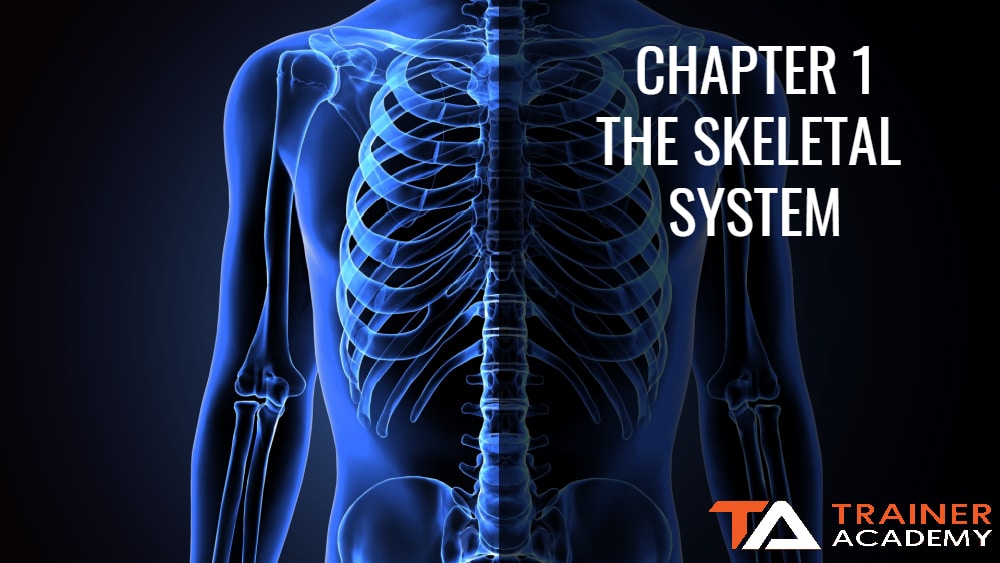Understanding how to design an effective program seems an easy task; however, it can be an intensive process. Training programs guide an individual through their training in an organized fashion in order to achieve optimal results. Anyone can take several exercises and perform them in succession, but it is job of the fitness professional to use knowledge and common sense to pick the right set of exercises and perform them in the correct order to both maximize improvements in fitness and minimize risk of injury for the client.
Introduction to Basics of Program Design
Programs must consider a myriad of variables that may change the design fundamentally. Some variables involve the actual workouts while others involve the client’s strengths, limitations and goals. An endurance program will look vastly different compared to a strength program. An older client’s program will be in stark contrast to a younger client’s program. This chapter will cover different program variables and their uses as well as giving fitness professionals a way to organize training schedules to best fit the needs of a client.
Program Design Variables
A training program requires manipulation of multiple variables to be effective. Each variable carries important factors with it. Each variable’s manipulation may alter how a program affects a client’s progression. The following will explain important training variables that will be a part of every training program.
Sets
A set is a grouping of several repetitions of an exercise or a number of reps performed without rest.1 Most workout programs include several sets per exercise. However, some may only use one set per exercise for beginners or one extended set. Exercises will typically have 1-3 warm up sets followed by 3-5 working sets. A warm up set uses lighter weights to prepare the body for the working sets, while a working set is the set using the assigned intensity, reps, and tempo. Usually a rest break is required between sets, which can vary from a few seconds up to ten minutes depending on the goals of the workout.
Reps
A repetition, or rep, is one instance of an exercise. One set will have 1-30 reps typically. Different rep ranges are related to the type of stimulus they typically provide a muscle or muscle group. Each rep range is related to either hypertrophy, strength, power, muscular endurance, or a multiple other training goals discussed later. Generally most reps involve moving the weight to its required destination and then back, although in some instances reps involve no movement or partial range of motion.
Intensity
The intensity of an exercise typically refers to its percent of a 1 repetition max (%1RM). Intensity levels correspond to different goals. For example, 90% 1RM or higher is typically related to power, maximal strength, and for some athletes, a peaking phase. Different intensity ranges will be discussed later in this chapter. Intensity can also refer to how challenging a rep or set feels to the individual based on the rate of perceived exertion (RPE).
Tempo
Repetition Tempo, or rep tempo, is the speed at which a rep is performed during a given set. Rep tempo is often displayed as 3 to 4 digits, such as 2-1-2 or 2-1-2-0. 2-1-2 denotes a 2 second eccentric phase, 1 second pause at the bottom of the rep, and 2 second concentric phase. The fourth number would represent the time between finishing one rep and starting the next. A slower rep tempo has been shown to be more effective than a typical one when it comes to hypertrophy, but the difference is insignificant when a set is pushed to a similar proximity to failure.
Volume
Training volume is an accumulation of how much work a trainee performs in a given workout or program. To find training volume, multiply sets, reps, and the weight used. For example, a lifter performs 4 sets of 15 reps at 225lb on the back squat. Their training volume will be 13,500lbs of training. It is important to note that 15 sets of 4 reps at 225lb may equal 13,500lbs of training volume, but it is not the same stimulus, because of the rep range and relative intensity.
Training volume is also considered on a weekly basis. The total amount of sets performed on a body part is crucial for hypertrophic progression.
Currently the MV, MEV, MAV, and MRV systems are a common measure for weekly training volume. MV, or maintenance volume, is the number of weekly sets to maintain current amounts of muscle. MEV, or minimum effective volume, is the minimum weekly number of sets for a muscle or muscle group to grow. MAV, maximal adaptive volume is the optimal number of sets performed in a week for a muscle or body part to grow. Finally, MRV, or maximum recoverable volume is the maximal number of sets that a client can perform and still recover for that body part’s next training session.
Rest
A rest interval describes time between sets that is dedicated to acute recovery, or the ability to recover enough to perform the next set. The rest interval typically lands in between 30 seconds and 180 seconds. Shorter rest periods (30-60 seconds) are linked with greater hypertrophic responses while longer rest periods (3-5 minutes) are linked with greater maximal strength responses.2 What is more important, is that the trainee takes enough time to fully recover before the next set without taking so long that they are not prepared for the next set. Some rest periods go as long as ten minutes or more if needed.
Frequency
Training frequency defines how many times someone trains a body part per week. Beginners usually start with once a week and high level athletes may train 6-8 times a week, including days where they train twice in that one day. Training frequency typically requires an inverse relationship with training duration in order to accumulate enough training volume per week for growth.
Duration
Training duration describes how long a training session lasts. Typically, a training session lasts 30 minutes up to 2 hours depending on workout structure, rest intervals, training volume, and, of course, time wasted. In some cases, training sessions can be shorter than 30 minutes or longer than 2 hours, but this is beyond the scope of this text.
Exercise Selection
Exercise selection is self explanatory. The exercises a trainer or coach picks change according to goals, time, and equipment available. A bodybuilder uses certain exercises that differ from a powerlifter. A lifter with a knee injury will pick different exercises than a lifter with no injuries. A gymnast will perform different exercises than a football player, and so on. Poor exercise selection can also increase the risk of injury. Heavy movements paired with explosive movements afterwards can be detrimental for some lifters, or high rep exercises followed by sprints. Proper exercise selection can maximize the utility of a training session and should be sports-specific.

Selecting Variables for Common Fitness Goals
A coach or trainer must design a program that focuses on achieving the client’s personal or sports-related goals. There are five common overall training goals: stability, muscular endurance, hypertrophy, strength, and power. While several of them have overlap, training for each can be quite different.
Stability
Stability training refers to training with the intention of improving balance and neuromuscular control, normally handled by type I muscle fibers. This kind of training goal commonly includes beginners, people recovering from injuries, and individuals interested in activities such as yoga. Reps can be moderate or high depending on the experience of the client, or reps can be time based. Loads are typically very low in this category while reps are high or time based. Coaches often program low training volume because of the nature of this kind of training. Exercises include use of unstable surfaces or unilateral, or single sided movements. New trainees need to build up their stability for heavier lifts later in the training career, so while this is an individual training goal for many, it is also a stepping stone.
Muscular Endurance
Muscular endurance refers to the ability for a muscle to produce force for extended periods of time. Muscular endurance training focuses on type I muscle fibers. This occurs through long training sessions that seek to emulate the requirements of endurance events, or for occupations that require endurance on a day-to-day basis. There are no specific exercises more conducive to muscular endurance training. Muscular endurance training usually requires low intensity loading with a high number of reps, such as 15 or more at below 60% 1RM.3 In some cases, workouts include a higher amount of working sets, but usually, muscular endurance training will keep working sets on the lower end, usually around three sets per exercise.
Hypertrophy
Hypertrophy refers to the growth of muscle. Hypertrophy training benefits most training goals, but many trainees are primarily concerned with just increasing muscle mass. Hypertrophy training involves all muscle fibers, but type II fibers are larger and more conducive to hypertrophy. Clients seeking this goal range from the typical gym goer who wants to look better to an aspiring bodybuilder or powerlifter preparing for their next strength phase.
Most resistance training movements are effective for hypertrophy, but many bodybuilders will opt for machines when applicable to remove some unnecessary fatigue from the stabilization of free weights. Hypertrophy can be elicited with sets of 5-30 reps, but more often trainees use sets of 6-12 reps with medium to high loads and low to moderate rest intervals at or greater than 30% 1RM.4,5 A 1-3 second concentric phase and a 2-4 second eccentric phase is cited to be the optimal rep tempo for muscle growth.6 A 30-60 second rest interval between sets suits hypertrophy training in many cases, although this can be individual, exercise, and muscle dependent. Hypertrophy blocks often use a higher variety of exercises to train different muscle fibers and high volume training.
Strength
Maximal strength refers to a trainee’s ability to produce maximal force. Maximal strength training mostly involves type II muscle fibers. Clients interested in strength training fall into two categories: trainees who want to be generally stronger in their daily life, and strength athletes like powerlifters, strongmen, and other athletes from mainstream sports. Maximal strength training typically includes compound movements (movements in which multiple joints move at once) which involve as many muscle fibers as possible per exercise. Maximal strength training involves lower volume than hypertrophy training, but high loads with 1-5 rep sets, but strength increases have been observed at working sets at or below sets of 20.7 Strength training seems to be optimal when loads are at or higher than 80% 1RM, but significant strength gains can still be elicited at lower loads.8 3-5 minute rest periods (or longer sometimes) are best for maximal strength training physiologically and psychologically. Maximal strength training also benefits from high volume training depending on the trainees current mesocycle (see Periodization for more info).
Power
Power oriented goals center around the ability to produce a high degree of force quickly, handled by the type II muscle fibers.
Many athletes look into power training to maximize their speed and explosiveness during competition, but this specific style of training is not not recommended for novice lifters.
Novice lifters will often increase overall power during a strength or hypertrophy cycle, because those adaptations will stimulate some power increases in the de-trained. Olympic lifters use power training because their sport revolves around being explosive. Like maximal strength training, multi-joint compound movements are preferred to build power. Power training uses either between 85-100% 1RM to improve force production or 30-40% 1RM to improve speed. Power training typically utilizes low volume, using sets of 1-3 reps with medium to high loads as fast as possible with good form. Rest intervals should be between 2-5 minutes for proper recovery between sets.9 In many cases, power goals can also be considered the peaking phase in a program’s periodization.
In many long term program designs, a trainer or coach will take their trainee through all of these phases at some point in 2 to 8 week periods called mesocycles (see Periodization). The main takeaway is that there is some overlap with all of these training goals. One will lead into another or will benefit another.
Subgoals
Subgoals can align with one of two of the more common goals. Many individuals have the desire to increase bone density, such as women at risk for osteoporosis. Resistance training positively correlates with improved bone density in randomized control trials.10 In fact, any exercises with impact such as walking or running will typically benefit bone density. The only exercises that do not benefit bone density are exercises like swimming or cycling which have low loads and no impact. While movements with impacts such as running or walking are beneficial for bone density, resistance training is more potent than cardiovascular exercises in increasing bone density.11
Clients may be interested in reducing injury. Resistance training has been shown to prevent acute and overuse injuries.12 Targeted resistance reduces chronic pain more than other exercise intervention.13 Increased muscle size and strength come with stronger denser bones and tougher connective tissue. Tendons and ligaments grow at a slower rate than muscle and bone, but they are benefited by training nonetheless. Strength training also reduces many forms of chronic pain. Chronic pain is often caused by muscle imbalances, which benefit from correctly trained muscles. Also, many people have inactive muscles or mobility restrictions from daily activities like excessive sitting, which can be corrected with a well balanced resistance training regiment.
For athletes of all kinds, speed, agility, and quickness (SAQ) is the focus. Again, all of the common training goals contribute to SAQ, but power training teaches the body to be explosive with each step or jump in generating speed. Resistance training improves connective tissue toughness and bone density to better resist the stresses placed on the body during sudden changes in direction. Plyometric training, or plyo training, also is benefitted by power training. Both plyo and SAQ training are explored further in other chapters.
Possibly the most common goal among most clients is weight loss. The most common strategy for weight loss includes a high degree of cardio, but resistance training can be extremely effective for long term weight loss and maintenance. Resistance training has been connected with decreases in obesity related conditions, but may not be the quickest way to reduce visceral body fat.14 Basically, aerobic training may be the quicker path to weight loss, but resistance training correlates with overall better health outcomes in the long-term. Particularly, as a trainee increases muscle mass, their base metabolic rate (BMR) increases, which helps long term weight loss and lowers obesity related health risks. The second benefit of hypertrophy training for weight loss is that the higher volume will burn more calories and help create the caloric deficit required for weight loss.
Programming Considerations Based On Client Type and History
Each kind of client may have different needs that will affect the way a trainer gets them to their goals. One client may have a knee injury while another may be older and have a heart condition. The type of client dictates how a program is designed outside of goals.
A client’s program may be dictated by their training age or experience. A program designed for a beginner will look vastly different to a program designed for a ten year veteran. A beginner may not understand how their body reacts to training and will usually be better off with a lower volume program. On the other hand, a training veteran may need a much higher volume training because that may be needed to stimulate growth.
Biological age is a major factor in designing a program for a trainee. Younger clients may be able to handle more volume and heavier loads because their body is in its prime. Recovery time for younger trainees is typically faster than older trainees. Older trainees may not be able to handle high weekly volume. Assigning high volume to an older client may not allow them to recover and risk them developing injuries. Older clients may also not be able to handle as high an intensity as younger clients in some cases so it may be better to assign them higher rep exercises.
In conjunction with biological age, recovery capacity is a vital variable to consider. Recovery capacity includes nutrition habits, sleeping habits, daily stresses, age, and training experience all may affect recovery capacity. A trainee with high stress may not be able to recover from a high volume or high training frequency, while a client with all of these factors in order may benefit from a more intense program.
Injuries plague clients of all kinds and must be considered when designing a program. Injury history may dictate how much volume a trainee may be able to undertake for a certain body part. A trainee with a history of torn ACLs may not be able to do much, if any at all, leg exercises requiring high loads or large ranges of leg motion, while a trainee with a history of shoulder injuries may need to progress slower with their shoulder work than a trainee with perfectly healthy shoulders. Every injury requires its own considerations and adjustments.
As mentioned before, a client’s lifestyle can affect their ability to recover and thus their ability to handle more intense training programs. However, some clients may have less time to train so this may affect their workout structure. Circuit training or supersets may be better for CEOs while pyramid sets may be better for professional athletes. A trainee with no equipment available will need a different program than one who goes to a gym on a regular basis.
Nutrition is a massive factor in a training program. A training program with an extremely high training volume will be wasted with poor nutrition. For example, college students often have poor nutrition habits and may not get the most out of their training programs.
Example Training Templates for Various Goals
The following are a few example programs for common training goals.

Scheduling Workout Splits
When designing a template for a client or athlete to follow, consider both the client’s scheduling limitations and their ability to recover from session to session. The number of days trainees can workout (or want to workout) every week, the amount of time in those days, and the trainee’s level of experience dictate the number of days in the microcycle (week of training) and the appropriate volume and muscle split used on those days.
Full Body Routines
Full body workouts are ideal for beginners, for trainees who have little time to train, and for people who want a low-level of training frequency per week. Clients using a full body routine can get the appropriate amount of training stimulus to enact big changes in their body with only 2 or 3 workouts per week. Athletes often use this template, because sports-specific drills and practice takes up much of their weekly time. Full body splits involve training the entire body, using compound movements because of time and energy restrictions, each time the trainee works out.
Upper/Lower Splits
Upper and lower splits require the trainee to split up sessions between training their upper and their lower body. Intermediate-level exercisers often use upper/lower splits, because it allows them to focus more closely on individual body parts and train more often, although more advanced trainees may require a further split, like a push/pull/legs or individual body part split to achieve the maximal results. Exercisers in this model workout 2, 4, or 6 days per week depending on their goals and time availability.
Push/Pull/Legs
Push/pull/legs splits the body even further into 3 days of training. On day one, the trainee exercises the muscles which push (shoulders, chest, triceps), on day two they train the pulling muscles (back, biceps, forearms) and on day three they train their legs. Day four can either be a rest day or a repeat day where the client goes back to a push day. Most trainers will never use this split with a client unless they train the client every day or trust that the client knows what they’re doing and will workout diligently and safely on their own. This model requires a 3-days per week exercise cycle or 6-days per week.
Body Part Split
In this split, the exerciser trains individual muscles in every workout. This is a highly variable template and should only be used by advanced athletes and competitive bodybuilders to achieve maximal results.
Summary
Programming workouts requires the use of variables such as sets, reps, volume, intensity, rest, frequency, duration, and exercise selection. Fitness professionals should also consider the client’s goals, as well as age, injuries, and training history. Some goals will be able to coexist together in an exercise program as subgoals while others need to be placed on hold until the client achieves the primary goal. In addition, personal trainers should factor in the schedule of the client and level of experience when designing weekly templates for various body parts and movement patterns.
References
- Schoenfeld BJ. The mechanisms of muscle hypertrophy and their application to resistance training. J Strength Cond Res. 2010;24(10):2857-2872. https://doi.org/10.1519/JSC.0b013e3181e840f3
- de Salles BF, Simão R, Miranda F, Novaes Jda S, Lemos A, Willardson JM. Rest interval between sets in strength training. Sports Med. 2009;39(9):765-777. https://doi.org/10.2165/11315230-000000000-00000
- Schoenfeld BJ, Grgic J, Van Every DW, Plotkin DL. Loading Recommendations for Muscle Strength, Hypertrophy, and Local Endurance: A Re-Examination of the Repetition Continuum. Sports (Basel). 2021;9(2):32. Published 2021 Feb 22. https://doi.org/10.3390/sports9020032
- Schoenfeld BJ. The mechanisms of muscle hypertrophy and their application to resistance training. J Strength Cond Res. 2010;24(10):2857-2872. https://doi.org/10.1519/JSC.0b013e3181e840f3
- Schoenfeld BJ, Grgic J, Van Every DW, Plotkin DL. Loading Recommendations for Muscle Strength, Hypertrophy, and Local Endurance: A Re-Examination of the Repetition Continuum. Sports (Basel). 2021;9(2):32. Published 2021 Feb 22. https://doi.org/10.3390/sports9020032
- Schoenfeld BJ. The mechanisms of muscle hypertrophy and their application to resistance training. J Strength Cond Res. 2010;24(10):2857-2872. https://doi.org/10.1519/JSC.0b013e3181e840f3
- Schoenfeld BJ, Grgic J, Van Every DW, Plotkin DL. Loading Recommendations for Muscle Strength, Hypertrophy, and Local Endurance: A Re-Examination of the Repetition Continuum. Sports (Basel). 2021;9(2):32. Published 2021 Feb 22. https://doi.org/10.3390/sports9020032
- Schoenfeld BJ, Grgic J, Van Every DW, Plotkin DL. Loading Recommendations for Muscle Strength, Hypertrophy, and Local Endurance: A Re-Examination of the Repetition Continuum. Sports (Basel). 2021;9(2):32. Published 2021 Feb 22. https://doi.org/10.3390/sports9020032
- Suchomel TJ, Nimphius S, Bellon CR, Stone MH. The Importance of Muscular Strength: Training Considerations. Sports Med. 2018;48(4):765-785. https://doi.org/10.1007/s40279-018-0862-z
- Layne JE, Nelson ME. The effects of progressive resistance training on bone density: a review. Med Sci Sports Exerc. 1999;31(1):25-30. https://doi.org/10.1097/00005768-199901000-00006
- Layne JE, Nelson ME. The effects of progressive resistance training on bone density: a review. Med Sci Sports Exerc. 1999;31(1):25-30. https://doi.org/10.1097/00005768-199901000-00006
- Lauersen JB, Andersen TE, Andersen LB. Strength training as superior, dose-dependent and safe prevention of acute and overuse sports injuries: a systematic review, qualitative analysis and meta-analysis. Br J Sports Med. 2018;52(24):1557-1563. https://doi.org/10.1136/bjsports-2018-099078
- Tataryn N, Simas V, Catterall T, Furness J, Keogh JWL. Posterior-Chain Resistance Training Compared to General Exercise and Walking Programmes for the Treatment of Chronic Low Back Pain in the General Population: A Systematic Review and Meta-Analysis. Sports Med Open. 2021;7(1):17. Published 2021 Mar 8. https://doi.org/10.1186/s40798-021-00306-w
- Ismail I, Keating SE, Baker MK, Johnson NA. A systematic review and meta-analysis of the effect of aerobic vs. resistance exercise training on visceral fat. Obes Rev. 2012;13(1):68-91. https://doi.org/10.1111/j.1467-789X.2011.00931.x












